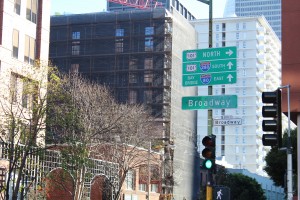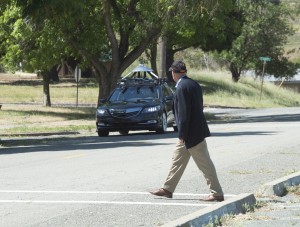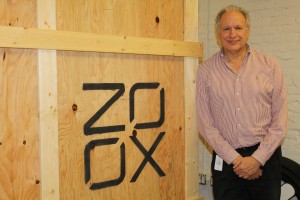A white Toyota Highlander rigged with cameras and sensors winds through San Francisco’s Financial District. It eases into an intersection, checks for pedestrians and allows oncoming traffic to pass before making a left turn. These turns are complicated for any driver in the city — but here, the person behind the wheel is only there to monitor the car as it navigates itself. This autonomous vehicle belongs to Zoox, a Menlo Park startup in the race to develop fully self-driving cars. As soon as next summer, test vehicles like this one may no longer need a backup driver sitting at the wheel, ready to take control in case of emergency.
The autonomous vehicle industry is booming. When Zoox applied for a permit to test vehicles on California public roads in March 2016, it was the twelfth company to receive one from the state DMV. Less than two years later, the number of companies with permits in California has risen to 44. Two of the most high-profile developers, Uber and Waymo (the self-driving car developer run by Google’s parent company, Alphabet) are now in the midst of a high-profile lawsuit over intellectual property.
California’s DMV is ahead of other states in regulating this new industry. Today, all test vehicles on public roads in the state require a permit and a backup driver. Companies must also file detailed reports about car accidents and disengagements — when a backup driver takes a car out of autonomous mode and regains control of the wheel.
But now the department is pushing through regulations that would allow companies like Zoox to test cars without backup drivers. The rules would also allow for public use of autonomous vehicles (Cars like Tesla that have autopilot modes aren’t considered fully autonomous). The DMV is accepting public comments on the latest draft regulations until December 15.
California’s DMV is walking a tightrope between fostering innovation in driverless technologies in the state while ensuring companies are transparent about their testing and maintaining public safety. Industry advocates say some of the department’s requirements slow down the developers of autonomous technology, while consumer rights advocates say the DMV is moving too quickly.

“We want to get this right,” Jessica Gonzalez, a DMV spokesperson, said. “We don’t want to put something out there that’s going to put the public in danger, but we also want to make sure…that if technologies or companies are ready to do this, we want to have that path available to them.”
Clearing the road for autonomous vehicles
Twenty-two states have guidelines on autonomous vehicle use. But most of those have only the “barest outlines” of rules, says Bryant Walker Smith, a University of South Carolina law professor and legal expert on self-driving cars.
According to Gonzalez, such regulations would normally be federally mandated. But when California passed its first autonomous vehicle law in 2012, federal officials were not yet ready to create a national policy. “They were like ‘We can’t, it’s going to take us 10 years to write these.’”
Earlier this year, a bill passed in the U.S. House of Representatives that would have federal transport agencies regulate autonomous vehicle design and performance standards, as well as decide whether to exempt thousands of vehicles from safety standards like having a steering wheel. A similar bill is working its way through the Senate.
For now, there’s a patchwork of state regulations, with some states having no laws governing self-driving cars. “Arizona doesn’t have any rules,” Gonzalez said, “so you can do anything you want.” Waymo began testing vehicles without backup drivers in the Phoenix area last month.
In December 2016, Uber began testing self-driving cars in San Francisco without obtaining a permit. The state DMV revoked the cars’ registrations after the company refused to apply for a self-driving permit. Three months later, Uber applied and received one.
“California is unique in that California gets to do things that no other state gets to do,” said Smith. Self-driving car developers prefer to build and test in California despite having more regulations because the state has major technology companies and skilled employees in Silicon Valley, sources of venture capital funding and, most importantly, residents who are likely to be some of the first customers for self-driving vehicles.
“If any other state wanted to impose these kinds of requirements, not that they’re onerous …developers would have said no, thanks, we’ll go to your neighbor,” he said.
Today’s testing landscape

Zoox, a three-year-old startup, first took to the streets with its self-driving car software in January 2017. The company has 11 cars and 60 drivers approved by the DMV, and tests on public roads in busy San Francisco.
While Zoox is testing its artificial intelligence software in Toyota Highlanders, the company is also designing a futuristic vehicle and a ride-hailing app. It aims to deploy its first cars in 2020. Zoox is looking at a fully electric fleet with carriage seating (where passengers sit facing each other) and no steering wheel or brake pedals, according to Mark Rosekind, the company’s chief safety innovation officer.
The company has raised $290 million in funding, according to Crunchbase, and is testing prototypes of the fully driverless vehicle in an undisclosed location in Menlo Park — but not on public roads.
Across the Bay, at an old naval weapons station in Concord, other autonomous vehicles are learning to drive and handle rough conditions on a closed track. The facility, GoMentum Station, is run by the Contra Costa Transportation Authority. Companies including Honda, artificial intelligence company Baidu and Uber’s self-driving truck arm, Otto, use the facility.
Randy Iwasaki, executive director of the county transportation authority, emphasized the importance of working on a closed track before moving to public roads. Video footage from Honda’s experiments at GoMentum Station show an Acura vehicle driving around a test environment with buildings, trees and stop signs. The car stops for pedestrians at crosswalks and swerves to avoid a mannequin standing in the middle of the road.
“Imagine trying to do that in real life, and God forbid if something happened,” Iwasaki said.
Are drivers ready to let go of the wheel?
As companies continue to develop and test their artificial intelligence tools, they still face a last barrier to adoption: earning the public’s trust.

More than half of Americans say they are “somewhat worried” or “very worried” about the development of driverless cars, and wouldn’t choose to ride in a driverless vehicle if they had the opportunity, according to a Pew Research Center study published earlier this year. Of those skeptical of riding in an autonomous vehicle, the top concerns were safety and a lack of trust in handing over control to the technology.
And on the road, there are signs that drivers have trouble interacting with self-driving test vehicles. Of the 51 autonomous vehicle accident reports submitted to the DMV, the majority occur when a vehicle rear-ends a self-driving car.
Most of these accidents have been minor bumps, with seven resulting in minor injuries. But Consumer Watchdog believes the accidents show it’s too early to take out the backup drivers from autonomous vehicles.
“These cars are not yet ready to go out on the road without chaperones,” said John Simpson, director of the organization’s privacy and technology project. “I think they’re getting lots of pressure from industry. These companies are falling victim to the hype of what these cars may someday be able to do, rather than dealing with the reality as it now exists,” he added.
Rosekind believes some of the apprehension around autonomous vehicle testing is about trust. He said, “For all the loud voices sometimes about the safety, I think we’re talking about things much more basic, which is humans giving up control to an automated system.”
